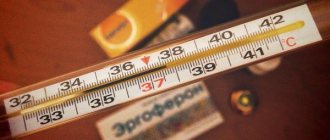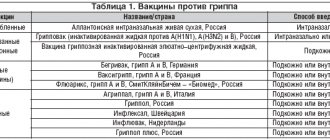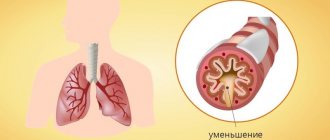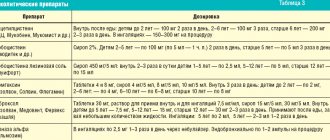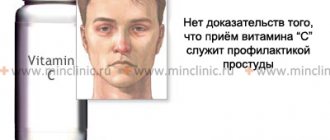General information
Affective-respiratory attacks are attacks of spasmodic crying or severe anxiety of a child with “sunset” in conditions of a negative emotional reaction. They are most often observed in children from six months to one and a half years and manifest themselves in the form of episodic short-term breath holding ( apnea ), which can be accompanied by apneic convulsions and loss of consciousness .
Despite the frightening manifestations, seizures are not life-threatening for the child, and subsequently, upon reaching the age of three to five, they disappear spontaneously, and therefore do not require treatment. No more than 5% of the population suffers from affective-respiratory attacks, regardless of the gender of the child. A positive family history was identified in 25% of cases.
Educational program
First, let's figure out what affective-respiratory attacks are. It is a benign paroxysmal non-epileptic disorder. Occurs in 0.1-4.6% of all young children. Most often seen in children between 6 months and 6 years of age, the first attack most often occurs at 18 months of age. The attack is as follows: during strong crying, the child holds his breath, does not breathe for several seconds, usually less than a minute, and then loses consciousness.
Within a minute, breathing is restored and the child regains consciousness. Despite the fact that it looks scary, this condition does not harm the child in any way.
The causes of the attack are unknown, but it has been proven that there is a genetic predisposition to the occurrence of the attack. 20-35% of such children have relatives who had affective-respiratory attacks in childhood.
Most children with affective-respiratory disorders have 1 to 6 such attacks per week, but about 15-25% of such children may also have up to several episodes per day. Most often, attacks occur between 12 and 24 months of age.
Pathogenesis
Affective-respiratory manifestations occur in conditions of increased nervous reflex excitability and a tendency to hysteroid reactions. When a child cries or screams, a spasm of the larynx occurs and breath holding may occur during the inhalation stage, which causes pallor or cyanosis of both the skin and mucous membranes of the mouth. The result of developing hypoxia is a disruption of the regulation of the autonomic nervous system, the development of tonic convulsions, and short-term fainting, which last from several seconds to several minutes.
Treatment
Regardless of the presence of iron deficiency in the body, the administration of iron supplements in a therapeutic dosage for a period of 16 weeks improves the situation not only in children with anemia, but also in children without signs of deficiency.
Try to avoid situations that provoke an attack. As practice shows, this is almost impossible, but it’s worth a try.
Fortunately, this attack does not remain with a person for life and passes on average by 4 years, by 8 at most.
Children with affective-respiratory attacks are absolutely no different from other children; their intellectual and neuropsychic development remains at the level of their peers. At the same time, the risk of developing epilepsy does not increase, but fainting occurs more often in adolescence.
Affective-respiratory attacks are attacks during which a child holds his breath for several seconds while crying, which leads to loss of consciousness. In some cases, seizures may occur, depending on the type of seizure. The attack itself lasts from a few seconds to a minute and does not pose any threat to the life and health of the child. The attack passes by 4-6 years, maximum by 8 years. The most important thing for parents whose children have had such an attack is not to panic and see a doctor to prescribe the necessary examinations to rule out more severe pathologies of the body. Take care of yourself and your children and be healthy!
Classification
Depending on the pathogenesis and completeness of the clinical picture, effective respiratory attacks in children are of different types:
- The usual type is a classic manifestation of an affective-respiratory attack - holding your breath while inhaling, which occurs as a result of injury or frustration - the inability to satisfy certain needs, outwardly resembles laryngospasm .
- Blue type - neurotic or neurosis-like attacks are the result of anger, frustration, and sometimes pain; while crying, the child may exhale forcibly, holding his breath occurs, which causes vegetative-vascular disorders: cyanosis (blueness of the skin), loss of muscle tone, dilated pupils and syncope, most often children regain consciousness on their own or fall asleep for several hours; This type of affective-respiratory seizures is characterized by the absence of a postictal phase and a normal EEG.
- Pale or white type (affective-respiratory syncopation) - unlike the blue type, it causes pallor of the skin, asystole and occurs during crying or its absence; also, with a normal EEG, it leads to fainting and does not have a post-ictal phase.
- Affectively provoked epileptic seizures or the so-called complicated type are considered a more pronounced and severe form of the types of seizures described above, which begin as “blue” or “pale” and turn into a pseudo-epileptic seizure; the EEG outside of seizures is usually normal.
Affective-respiratory syndrome ICD: manifestations
Individual character greatly affects the state of the autonomic nervous system: the muscles in the child’s throat contract, making it impossible for him to breathe normally. Usually this state lasts no more than 1 minute. It manifests itself as follows:
- The patient ceases to control his emotions, he freezes and stops performing the usual breathing processes;
- Spasms appear;
- Ultimately, the child relaxes and regains his breathing. Affective-respiratory syndrome, which manifests itself in a mild form, allows the child to quickly regain consciousness and continue everyday life. After an attack, the child may calm down and fall asleep for several hours.
Provoke an attack:
- Fears;
- Irritations;
- Sadness, resentment;
- Excessive joy, strong excitement;
Causes
As a manifestation of a heightened emotional state, affective-respiratory seizures are the earliest manifestation of hysterical paroxysms and usually occur in response to:
- feelings of disappointment, anger, fear, joy and other strong emotional shocks;
- force feeding;
- severe pain, for example, when falling from a height, “pale syncopation” occurs as a result of reflex asystole, which is especially dangerous for children with heart disease.
neurasthenia and neurosis , overprotection, vitamin D metabolism disorders, hypocalcemia and hypohemoglobinemia can contribute to the development of attacks of abnormal breathing .
What to do after an attack?
If the attack occurs for the first time, then you need to contact your pediatrician to schedule the necessary examinations. Examinations are needed to exclude severe disorders of the body and confirm that the attack is affective-respiratory.
What examinations can be ordered?
- ECG followed by consultation with a cardiologist to exclude severe heart rhythm disturbances.
- ECG followed by consultation with a neurologist to exclude epilepsy. It is worth noting that an ECG will not always be necessary, sometimes the diagnosis is obvious, sometimes a more thorough examination is needed, for example, EEG monitoring. Your doctor will usually tell you about this.
- Clinical blood test and serum ferritin test. It has been proven that such attacks can be associated with iron deficiency. The doctor may prescribe iron supplements based on test results, since it is known that increasing iron in the blood during deficiency reduces the number of attacks, and in 30-50% of cases stops them completely.
After examinations, when all serious pathologies are excluded and parents understand that there is no threat to the child, then subsequent attacks are tolerated much easier and calmer.
Symptoms
Depending on the type of affective-respiratory seizure, the symptoms may differ, but in general they consist of the following reactions:
- respiratory arrest caused by screaming or crying;
- turning blue or pale;
- severe hypotension (the child goes limp);
- short-term loss of consciousness, which may be followed by several hours of sleep;
- involuntary urination;
- the occurrence of seizures.
If affective-respiratory paroxysms are not stopped in time, then subsequently the child may experience hypoxia:
- short-term loss of consciousness;
- clonic-tonic or tonic convulsions ;
- post-attack lethargy and drowsiness;
- enuresis.
During an attack...
Still, do not forget about safety rules during an attack. Parents whose children are faced with such an illness should take emergency care courses, where they are taught how to properly perform artificial respiration, cardiac massage, and so on. These actions will not necessarily be useful, but you need to play it safe and be prepared.
What not to do during an attack:
- shake the baby
- splash cold water on it
- trying to put objects in your mouth.
What do we have to do:
- lay the child on his side,
- ensure safety if the child begins to move his head or limbs involuntarily.
Komarovsky about affective-respiratory attacks in children
The best person to explain what an affective-respiratory attack is is Dr. Komarovsky, popular and beloved by all mothers. In his television program “Ask Dr. Komarovsky,” he says that a seizure usually begins with a situation where a child is under the influence of some unpleasant external factors, for example, fear or refusal to do what he wanted, as well as pain and fright.
The child begins to cry hysterically, and his breathing stops for some time - so to speak, the child “breaks down crying.” In medical science, this condition is called an affective-respiratory attack, that is, in a state of uncontrollable negative strong emotion - in a state of passion , a sudden stop in breathing occurs.
As a rule, these paroxysms can begin after 6 months of life and, without any treatment, end sooner or later. Usually at a maximum of 4, extremely rarely - at 4.5-5 years, affective-respiratory attacks outgrow and they are a certain stage in the development of the nervous system. They, most often, do not need any treatment, although it is recommended to show the child to a doctor, because a situation can still be dangerous to health when:
- stopping breathing lasts more than a minute, this happens extremely rarely;
- in a child, severe reflex anoxic seizures with breathing stops for more than 30 seconds occur more often than 2-3 times a week.
What to do in case of affective-respiratory attacks?
The main task is to prevent the child from falling, and therefore from being injured, so it is best to calmly approach the baby, hug him, thereby preventing a fall. It is important not to make the parent himself hysterical and not to change his face. In addition, you can put something cold on the child's face or even wet your hand with cold water and splash it on the child. The main thing is to treat this calmly; the child always outgrows it if the syndrome is not a reason for personal hysterics and panic among parents and relatives.
If the seizure was provoked by the failure to fulfill the child’s wishes, then you need to understand that after the child has come to his senses, you cannot succumb to provocation - do not do what the baby wanted, do not discuss what happened and do not punish. It’s good if the mother or father pretends that nothing happened. Otherwise, you are suggesting the wrong mechanism for solving problems and contributing to the development of neurasthenia in the future.
Affective respiratory syndrome: causes
Following ICD 10, Affective-respiratory syndrome can be classified as a group of hysterical personality disorders. But it is important to realize that emotional swings in a child do not always manifest themselves in apnea attacks.
Affective respiratory syndrome in children is often compared to epilepsy, which occurs in a milder form. But do not forget that this is an independent disease that requires individual consideration and treatment. Based on the same ICD 10, it should be noted that Affective Respiratory Syndrome has its own code – F60.4.
At first glance, this disease seems dangerous and frightening, but in its essence it does not lead to death, but rather indicates serious pathologies in the child’s body. To better know the enemy in person, it is necessary to understand the causes of the disease.
